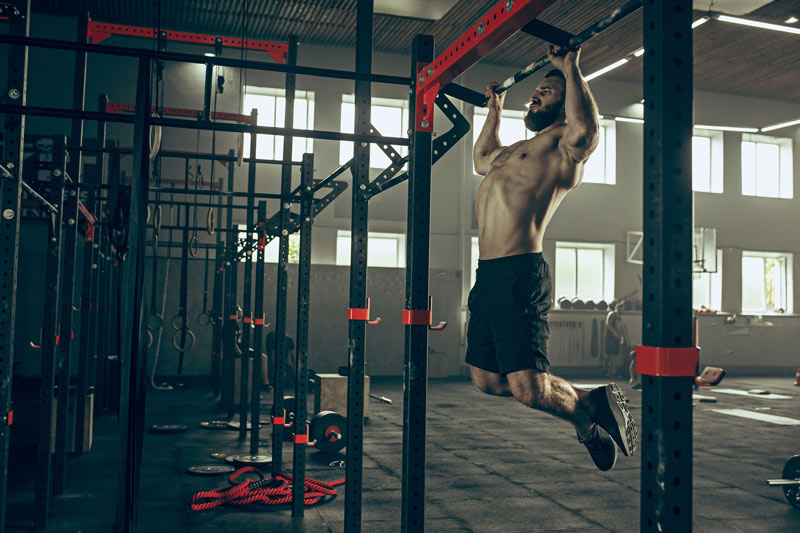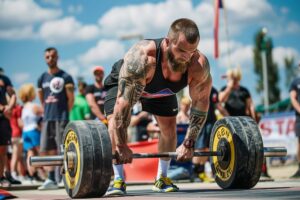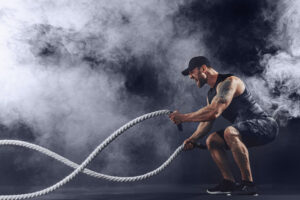If you’ve noticed that you’ve stopped gaining size, then it’s likely time for you to change up your workout routine. Our bodies are amazing, no matter what you throw at them, they adapt and do it fast. It is because of this that bodybuilders and athletes experience “plateaus”. This refers to periods when you’re not gaining strength or getting bigger, no matter how hard you work.
The process of building muscle is all down to your body adapting to increasing loads and stress. It should be as simple as:
- Lifting X amount of weight and your body grows more muscle to cope
- Up the amount of weight, your body then increases the muscle more to cope with the extra strain, and so on
However, if it was that simple, we’d all be huge!
Those who are into lifting will know that you’re not able to get continuous growth when you constantly follow the same program. Your body will adapt to the stress too quickly, meaning that your current routine won’t muster up any results.
Regularly changing your workout is vital for long-term growth. Professional bodybuilders switch up their workouts all the time, change the exercises they do, and add in advanced training techniques. Due to their experience and training, they know exactly what they need to do to burn fat and build muscle.
There are many techniques the pros use, that you can use too in order to stimulate muscle growth. So, let’s go through the ways you can switch up your routine to avoid plateaus.
1. Make it more intense

Now, we’ve put this one first as we believe it’s the most important. The intensity builds muscle. Many of the tips we’re going to give you will involve increasing the intensity of your workout in some way. The classic examples of these are slow reps, negatives, drop sets, and supersets.
You can also up the intensity of your routines by taking shorter rest periods, doing circuits, forced reps, etc. It’s easy to get stuck in a rut when you’ve been following the same routine for a while. You think you’re training hard when actually your intensity level is dropping without you realizing it.
2. Change up your exercises
All muscle groups have different exercises that can be used to train. Many weight trainers will end up stuck in the same routine of moves, week in, week out. It’s also common to leave out the exercises they don’t like.
However, to continue building muscle, you need to work your muscles with a wide array of workouts. You’ll also see the benefits of switching these regularly as you’ll use different muscles for different moves and you won’t get bored. Plenty of professional bodybuilders out there claim to have never done the same workout twice.
3. Introduce drop sets
This one is a shock technique that if done correctly, can blast you through a hard plateau. Drop sets work by getting more reps out of you by gradually dropping the weight off. It forces more blood into the target muscle group, therefore, causing more muscle tearing. Now, this is what produces growth once the muscle tissue has been repaired.
Also Read: What you need to eat to bulk up
Drop sets are really quite simple. You keep going with your set until you can do another rep, drop the weight, do another set, and so on. To achieve results, do anywhere from 3 to 6 sets in total. One of the most common types of drop sets is known as “down the rack”. They’re dumbbell bicep curls where you start with a normal curl weight and move down the rack.
4. Work different muscles each day
Switching up the days you work out can have a big impact on your results. It’s a sensible idea to work your weakest muscles at the beginning of the week when you have the most energy. However, like everything else in your routine, you’ll reap the benefits of change and this allows muscle groups to rest whilst you work with others.
For instance, it wouldn’t be wise to work biceps on Monday and then your back on a Tuesday. You’ll need your biceps for all the pulling exercises that will strengthen your back. You can also change up your workout days so the first day of your workout week is focused on a different muscle group.
5. Get in those supersets

When it comes to stubborn muscle groups, one of the best ways to promote muscle growth is the combination of big compound exercises and an isolation movement. An example of this would be bench press-falt bench flys.
To do this, you’d complete your bench press as normal but then immediately smash out a set of dumbbell flys. Big weights aren’t needed for this; instead, focus on muscle contraction. By this we mean, slow it down and squeeze at the top of the movement.
Here are some great compound isolation supersets for you to try:
- Chin up then barbell curl
- Wide grip pull up then straight arm pull down
- Bench press then dumbbell flys
- Squats then leg extensions
- Close bench grips then skullcrushers
- Military press then front raises
6. Change reps weekly
Weekly rep cycling looks a little something like this:
Week 1 – 12 reps per set
Week 2 – 10 reps per set
Week 3 – 8 reps per set
Week 4 – 6 reps per set
Even though it is unclear as to how many reps are needed for optimum muscle growth, it’s somewhere between 6 and 12. Therefore, if you cover all bases by starting at 12 and ending at 6, you can’t go far wrong.
The key here is increasing the weight as you go, to up the intensity of your workout. If you’re following the right diet (which undoubtedly you are) then you should find that by week 5, you can lift way more than you could back in week 1.
7. Sometimes less is more
You may not think it, but when it comes to muscle building, less is actually more. A common mistake with new lifters is working out too often. If your goal is to get bigger then it’s more beneficial to work out less often. Your body will be grateful for the rest and will pay you in growth. So, instead of working out five or six days a week, perhaps drop that down to three or four.
8. Negatives
If building strength is one of your goals, then negatives will be extremely helpful to you in beating plateaus. Negatives are when you focus more on the negative part of your movement by using a very heavy weight and moving very slowly.
It’s important to use a spotter for almost all types of negatives. So, if you’re someone that typically trains alone, it’s probably best to give these a miss to avoid injuring yourself.
However, if you do want to give them a try and you’ve got a workout buddy, all of the below are great for negatives:
- Bench press
- Pull ups
- Close grip bench
- Barbell preacher curl
9. Slow reps
Now, slow reps are all about control and contraction. For these, you’ll use a lighter weight, move slower and do the same number of reps. A good idea is to use the 3-1-3 method. By this we mean count “1 one thousand” 3 times on the way down, pause for “1 one thousand” and then count for 3 “1 one thousand’ on the way up.
You may be doing the same number of reps, but because the movement is much slower, your body is under strain for a longer period of time.
10. Partial reps

Much like slow reps, alternate reps work your muscles by keeping them working for longer. For partial reps, what you’d be doing is modifying the exercise by not finishing the whole rep. Take alternating dumbbell curls as an example, instead of allowing your left arm to hang whilst your right arm curls, don’t complete the full rep and keep your left arm slightly bent.
Also Read: The 10 habits of a bodybuilder
Doing this stops the blood from escaping from the muscle and makes it work harder to hold onto the weight. By the time you’ve completed the set, your muscles have been under twice as much strain as regular alternating curls. This technique can also be used with the likes of:
- Dumbbell shoulder press
- Tricep extensions and kickbacks
- Dumbbell bench
11. Switch up your routine
If you were to ask a professional what order their exercises go in, they would likely say, big compounds first, then isolations.
However, just like everything else to do with your workout routine, your body will adapt quickly. So, switch up exercises and go for dips first on chest day and extensions before squats.
12. Pre-fatigue your muscles
Pre-fatiguing, also known as pre-exhausting, your muscles is a plateau-busting technique that has been around for years. What this does is pre-fatigue the muscle group you want to hit with an isolation exercise and then immediately follow that up with a big compound move.
Some examples of this for you to follow are:
- Front raise followed by military press
- Rear delt fly followed by row
- Flys followed by bench press
- Leg extension followed by squats
13. Forced reps
This one is nice and simple. Forced reps are when you do as many strict reps as you can without any help, then use the help of a spotter to force you through another two or more reps.
The forced rep technique could have you pushing 12 reps instead of 10 or you could up the weight and have your spotter help you reach the next level.
14. Pyramid sets
Well, as the name probably suggests, pyramid sets start from low weight and work their way up to a heavy weight, then back down again.
Once you’ve completed a proper warm-up, the first set in your pyramid should be a weight that you can pump out 12 reps in good form. With the next set, aim for 8 to 10 reps, then 6 to 8, then 4. You don’t have to, but if you want to push yourself in your workout, then work your way back up to the 12 reps to finish off.
What is important here is technique. Do not cheat. You want all your sets to be completed in a slow and controlled manner.
15. Have a week out
We’ve now arrived at the part that fitness fanatics tend to feel most guilty about… rest.
Bodybuilding and weight training are not like training for a marathon. As we’ve mentioned already, less is more. Sometimes you may feel like you can keep working out every day, but that’s not a sensible idea. Not only will your body adapt and the results will stop, but you’ll eventually burn out.
Also Read: Did I hear this right?
Sometimes, taking a week off is the best thing for you. Your body and mind need regular breaks from such intense weight training. Workout routines where you want to increase muscle and strength can put stress on your entire body, not just the muscles you’re working.
Your body will tell you when you need to take a break, but as a rough guide, it’s usually every 8 to 12 weeks.
The bottom line
Well, there we are. You can now get back in the gym and be ready to make changes so that you can start seeing results again.
If you take anything away from this, it should be that changing things up and resting is just as important as your gains. Don’t forget that your mind needs rest from the stresses of weight lifting.
Get BIG with Brutal Force

It can be hard to keep going when you’re not seeing results.
However, with Brutal Force the gains just keep on coming.
Whether you need products for a cutting cycle or to bulk up for the season, we’ve got it all. Also, there is no need to worry, all our products are 100% safe and made with all-natural ingredients. So, you can get HUGE gains, with NO side effects.
















